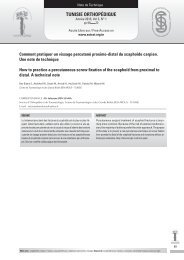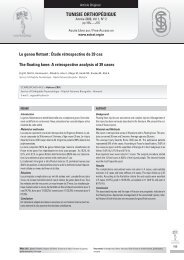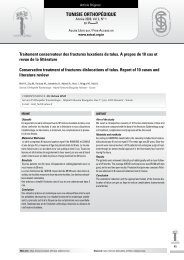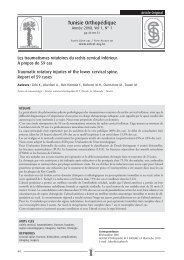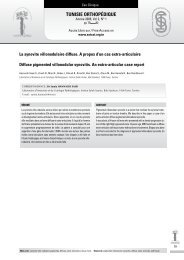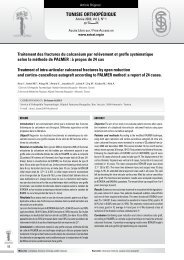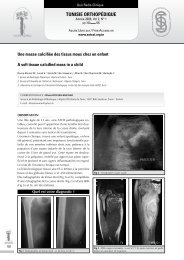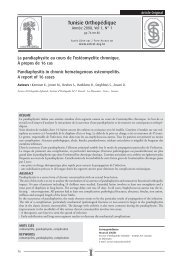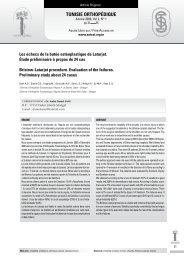e<strong>la</strong>tion entre <strong>la</strong> position <strong>de</strong> <strong>la</strong> butée et <strong>la</strong> stabilitépost-opératoire <strong>de</strong> l’épaule. Ils ont constatéque le risque <strong>de</strong> persistance d’une instabilité antérieureaugmentait significativement en cas <strong>de</strong>butée interne. Dans notre série, cette corré<strong>la</strong>tionn’a pas été confirmée.La lyse du greffon et <strong>la</strong> pseudarthrose <strong>de</strong> <strong>la</strong> butéen’ont pas constitué <strong>de</strong>s facteurs prédictifs <strong>de</strong>récidive <strong>de</strong> l’instabilité <strong>de</strong> l’épaule. Ceci a étéaussi constaté par A<strong>la</strong>in [14], Gazielly [10] etHovelius [8]. Selon ces auteurs, <strong>la</strong> stabilisation<strong>de</strong> l’épaule dans ces cas est expliquée par :La cicatrisation <strong>de</strong> <strong>la</strong> lésion <strong>de</strong> Bankart grâce àl’avivement du rebord antérieur <strong>de</strong> <strong>la</strong> glène.Le renforcement <strong>de</strong> <strong>la</strong> sangle muscu<strong>la</strong>ire antérieurepar le coraco-biceps et par <strong>la</strong> fibrose antérieurecicatricielle.Il parait que seule une pseudarthrose associéeà une lyse importante <strong>de</strong> <strong>la</strong> butée, emportantplus <strong>de</strong>s <strong>de</strong>ux tiers du greffon, <strong>pour</strong>rait altérer <strong>la</strong>stabilité post-opératoire <strong>de</strong> l’épaule. Walch [18]et Wymenga [11] pensent que cette associationannule l’effet butée et diminue <strong>de</strong> ce fait <strong>la</strong> stabilité<strong>de</strong> l’épaule.Vi. ConClusionL’étu<strong>de</strong> <strong>de</strong>s résultats <strong>de</strong> notre série fait apparaîtrecertains facteurs prédictifs d’échec fonctionne<strong>la</strong>près intervention <strong>de</strong> Latarjet.Les douleurs séquel<strong>la</strong>ires surviennent plus fréquemmentchez les sujets âgés <strong>de</strong> plus <strong>de</strong> 40 ans,et surtout en cas <strong>de</strong> débord <strong>de</strong> <strong>la</strong> butée.La mobilité post-opératoire <strong>de</strong> l’épaule est essentiellementcorrélée au type d’ouverture du musclesous scapu<strong>la</strong>ire et au dé<strong>la</strong>i et à <strong>la</strong> qualité <strong>de</strong> <strong>la</strong>rééducation post-opératoire. Une rééducationprécoce et <strong>la</strong> simple discision du muscle sousscapu<strong>la</strong>ire permettent une bonne récupération <strong>de</strong><strong>la</strong> mobilité articu<strong>la</strong>ire.La stabilité <strong>de</strong> l’épaule est essentiellement influencéepar <strong>la</strong> présence <strong>de</strong> signes d’instabilitémultidirectionnelle et par <strong>la</strong> position du greffoncoracoïdien. La position interne du greffon, et<strong>la</strong> positivité du Sulcus-test augmente significativementle risque <strong>de</strong> récidive <strong>de</strong> l’instabilité <strong>de</strong>l’épaule.Contrairement aux données c<strong>la</strong>ssiques <strong>de</strong> <strong>la</strong> littérature,l’âge du début <strong>de</strong> l’instabilité, le nombre<strong>de</strong> récidives et le dé<strong>la</strong>i opératoire ne semblent pasinfluencer le pronostic fonctionnel <strong>de</strong> l’intervention<strong>de</strong> Latarjet.Vii. réFérenCes1) Matton D, Vanlooy F, Geens S. Recurrent anterior dislocationsof the shoul<strong>de</strong>r joint treated by the bristow Latarjetprocedure: historical review, operative techniqueFacteurs d’échec du traitement <strong>de</strong> l’instabilité antérieure <strong>de</strong> l’épaule par l’intervention <strong>de</strong> Latarjetand results. Acta Orthop Belgica 1992; 58:16-22.2) Hovelius L, Björnsandström MD, Sundgren K. One hundre<strong>de</strong>ighteen Bristow Latarjet repairs for recurrent anteriordislocation of the shoul<strong>de</strong>r prospectively followedfor 15 years. J Shoul<strong>de</strong>r Elbow Surg 2004; 13:509-16.3) Tauber M, Resch H, Forstner R. Reasons for failure aftersurgical repair of anterior shoul<strong>de</strong>r instability. J Shoul<strong>de</strong>rElbow Surg 2004; 13:279-89.4) Huguet D, Pietu G, Bresson C, Potaux F, Letenneur J.Instabilité antérieure <strong>de</strong> l’épaule chez le sportif: à propos<strong>de</strong> 51 cas <strong>de</strong> stabilisation par intervention <strong>de</strong> LatarjetPatte. Acta Orthop Belgica 1996; 62:200-6.5) Singer GC, Kirk<strong>la</strong>nd PM, Emery RJ. Coracoid transpositionfor recurrent anterior instability of the shoul<strong>de</strong>r:A 20 year follow up study. J Bone Joint Surgery 1995;77B:73-6.6) Levigne C. Résultats à long terme <strong>de</strong>s butées antérieurescoracoidienne : à propos <strong>de</strong> 52 cas au recul homogène<strong>de</strong> 12 ans. Rev Chir Orthop 2000; 86:114-21.7) Guity M, Roques B, Mansat P. Epaule douloureuse ouinstable après butée coracoïdienne: résultat du traitementchirurgical. Rev Chir Orthop 2002; 88:349-58.8) Hovelius L, Björnc MD, Rosmark DL, Saebo M. Longterm results with Bankart and Bristow Latarjet procedures:Recurrent shoul<strong>de</strong>r instability and arthropathy.J Shoul<strong>de</strong>r Elbow Surg 2001; 28:445-52.9) Bonnevialle P, M Mansat. Les échecs <strong>de</strong> <strong>la</strong> chirurgie <strong>de</strong>l’instabilité antérieure <strong>de</strong> l’épaule. Conférence d’enseignement<strong>de</strong> <strong>la</strong> S.O.F.C.O.T 1995; 49:22-34.10) Gazielly D. Résultats <strong>de</strong>s butées antérieures coracoïdiennesopérées en 1995: à propos <strong>de</strong> 89 cas. Rev ChirOrthop 2000; 86:103-6.11) Wymenga AB, Morshuis WJ. Factors influencing the earlyresults of the bristow Latarjet technique. Acta OrthopBelgica 1988; 54:76-83.12) James K, Robert MD. Don’t forget the Bristow Latarjetprocedure. Clin Orthop 1994; 308:103-8.13) De<strong>la</strong>unay C, Lord G, B<strong>la</strong>chard JP, Marotte JH. P<strong>la</strong>ceactuelle du traitement <strong>de</strong>s luxations récidivantes et <strong>de</strong>sinstabilités antérieures <strong>de</strong> l’épaule par l’intervention <strong>de</strong>Latarjet. Ann Chir 1985; 5:293-304.14) Al<strong>la</strong>in J, Goutallier D, Glorion C, Glorion PH. Long termresults of the Latarjet procedure of treatment of anteriorinstability of the shoul<strong>de</strong>r. J Bone Joint Surgery 1998;80A:841-52.15) Picard F, Sarragalia D, Montbarbon E. Conséquencesanatomo-cliniques <strong>de</strong> <strong>la</strong> section verticale du musclesous scapu<strong>la</strong>ire dans l’intervention <strong>de</strong> Latarjet. Rev ChirOrthop 1998; 84:217-23.16) Roussel Y, Rol<strong>la</strong>nd E, Sail<strong>la</strong>nt G. Les récidives post-opératoires:résultats <strong>de</strong>s reprises chirurgicales. Rev ChirOrthop 2000; 86:137-47.17) Hawkins RH, Hawkins RJ. Failed anterior reconstructionfor shoul<strong>de</strong>r instability. J Bone Joint Surgery 1985;67B:709-14.18) Walch G, Charret Ph, Pietropaoli H, Dejour H. La luxationrécidivante <strong>de</strong> l’épaule: Les récidives post-opératoires.Rev Chir Orthop 1986; 72: 541-55.155Tun Orthop 2008, Vol 1, N° 2
Article OriginalTunisie OrThOpédiqueAnnée 2008, Vol 1, N° 2pp 156 162Accés Libre sur / Free Access onwww.<strong>sotcot</strong>.org.tnrésultats du traitement <strong>de</strong> <strong>la</strong> dysp<strong>la</strong>sie résiduelle <strong>de</strong> hanche par l’ostéotomie <strong>de</strong>salter. à propos <strong>de</strong> 40 casresults of salter’s osteotomy in the treatment of residual dysp<strong>la</strong>sia in <strong>de</strong>velopmentaldysp<strong>la</strong>sia of the hip. A review of 40 casesBouchoucha S., Smida M., Saied W., Safi H., Nessib M.N., Jalel C., Ammar C., Ben Ghachem M.Service d’Orthopédie <strong>de</strong> l’Enfant et l’Adolescent. Hôpital d’Enfants <strong>de</strong> Tunis.Tunis - TunisieCORRESPONDANCE : mahmoud smidaService d’Orthopédie <strong>de</strong> l’Enfant et l’Adolescent. Hôpital d’Enfants <strong>de</strong> Tunis.Tunis - TunisieE-mail : mahmoud.smida@rns.tn156résuméL’ostéotomie innominée <strong>de</strong> Salter est l’une <strong>de</strong>s techniques d’ostéotomie pelvienneles plus répandues <strong>pour</strong> le traitement <strong>de</strong>s dysp<strong>la</strong>sies cotyloïdiennesrésiduelles entrant dans le cadre <strong>de</strong> <strong>la</strong> ma<strong>la</strong>die luxante. Dans notre travail,nous étudions les résultats <strong>de</strong> cette technique à travers une série <strong>de</strong> 40ostéotomies en essayant <strong>de</strong> faire ressortir les facteurs <strong>qui</strong> influencent cesrésultats.Matériel et Métho<strong>de</strong>sEntre 1993 et 1997 nous avons pratiqué 40 ostéotomies innominées <strong>de</strong> Salterchez 26 enfants (14 ostéotomies bi<strong>la</strong>térales) <strong>pour</strong> le traitement <strong>de</strong> dysp<strong>la</strong>siescotyloïdiennes résiduelles après réduction d’une luxation congénitale<strong>de</strong> hanche <strong>qui</strong> a été dans tout les cas orthopédique. Il s’agissait <strong>de</strong> 23 filleset 3 garçons. L’âge moyen <strong>de</strong>s enfants à <strong>la</strong> réduction était <strong>de</strong> 33 mois avec<strong>de</strong>s extrêmes <strong>de</strong> 9 mois à 5 ans et 8 mois. Treize hanches présentaient uneostéochondrite post réductionnelle <strong>de</strong> gravité variable. Le recul moyen est<strong>de</strong> 6 ans et 1 mois, avec <strong>de</strong>s extrêmes <strong>de</strong> 3ans à 8 ans et l’âge moyen <strong>de</strong> nospatients au <strong>de</strong>rnier recul est <strong>de</strong> 9 ans avec <strong>de</strong>s extrêmes <strong>de</strong> 5 ans 3 mois à 12ans 6 mois. Les résultats ont été principalement analysés sur les paramètrescoxométriques suivants : L’angle VCE <strong>de</strong> Wiberg, l’angle HTE <strong>de</strong> Hilgenreiner,et l’angle conjugo-cotyloïdien (conjcot). Ces 3 mesures coxométriquesont été faites sur les radiographies prises à <strong>la</strong> réduction <strong>de</strong> <strong>la</strong> luxation, surles radiographies pré-opératoires immédiates, sur les radiographies postopératoiresprécoces en moyenne 2 mois après l’intervention, et sur les radiographiesprises au <strong>de</strong>rnier recul. Les hanches ont été c<strong>la</strong>ssées selon <strong>la</strong>c<strong>la</strong>ssification radiologique <strong>de</strong> Séverin.RésultatAu <strong>de</strong>rnier recul nous avons obtenu 82,5% <strong>de</strong> bons résultats radiologiques. Enpost-opératoire précoce, l’ostéotomie a permis une amélioration moyenne <strong>de</strong>14° <strong>pour</strong> l’angle VCE et <strong>de</strong> 11° <strong>pour</strong> l’angle HTE. Cette amélioration était <strong>de</strong>21° <strong>pour</strong> les 2 angles au <strong>de</strong>rnier recul. Quant à l’angle conjcot, ses valeursmoyennes ont peu varié d’une mesure à l’autre. Les complications <strong>de</strong> l’ostéotomieinnominée sont apparues rares et sans gravité. Par contre, le développement<strong>de</strong> déformations <strong>de</strong> l’extrémité supérieure du fémur à type <strong>de</strong> coxa valgaet <strong>de</strong> coxa magna séquelles d’ostéochondrite post-réductionnelle, altère lerésultat final en entraînant une découverture progressive <strong>de</strong> <strong>la</strong> tête fémorale.mots clés : ostéotomie innominée, luxation congénitale <strong>de</strong> hanche,dysp<strong>la</strong>sie résiduelleABsTrAcTPurposeTo study the results of the Salter innominate osteotomy in residual acetabu<strong>la</strong>rdysp<strong>la</strong>sia after orthopaedic treatment in DDH.Material and methodsIn the period 1993 - 1997, 40 Salter innominate osteotomies had been donefor residual acetabu<strong>la</strong>r dysp<strong>la</strong>sia in 26 children, 23 girls and 3 boys with amean age of 43.8 months (extremes: 18 and 81 months). The mean followupis 6 years 1 month (extremes: 3 and 8 years). The results were analyzedby measuring the Wiberg angle (VCE), the Hilgenreiner angle (HTE) and theCONJCOT angle. Then, the hips were c<strong>la</strong>ssified with Severin c<strong>la</strong>ssification.ResultsRecording to Severin c<strong>la</strong>ssification, we had 82.5% of good results and themean angle gain was 21° in VCE and THE angles. The CONJCOT angle wasnot reliable. A poor result was noted because of the happening of a preoperativeosteochondritis.Keywords : innominate osteotomy, <strong>de</strong>velopmental dysp<strong>la</strong>sia of the hip, residua<strong>la</strong>cetabu<strong>la</strong>r dysp<strong>la</strong>sia
- Page 2 and 3: Tunisie OrThOpédiqueOrgane Offi ci
- Page 4 and 5: SommaireTunisie OrThOpédiqueAnnée
- Page 6 and 7: ÉditorialTunisie OrThOpédiqueAnn
- Page 8 and 9: Orthopédie signifie, d’après le
- Page 10: Conférence d’ActualitéTunisie O
- Page 14: les chances de mise en évidence de
- Page 19: Tun Orthop 2008, Vol 1, N° 2124Ben
- Page 22 and 23: • Douleurs articulaires exacerbé
- Page 24 and 25: d’une antibiothérapie par voie o
- Page 28 and 29: 57) Yagupsky P, Press J. Use of the
- Page 30 and 31: i. teChnique ChirurGiCaleL’interv
- Page 32: Article OriginalTunisie OrThOpédiq
- Page 35: Tun Orthop 2008, Vol 1, N° 2140Zar
- Page 38 and 39: Article OriginalTunisie OrThOpédiq
- Page 40 and 41: Résultats de l’ostéotomie tibia
- Page 42 and 43: Résultats de l’ostéotomie tibia
- Page 44 and 45: Résultats de l’ostéotomie tibia
- Page 46 and 47: i. introduCtionLe traitement de l
- Page 48 and 49: C- Résultats cliniquesAu dernier r
- Page 52 and 53: i. introduCtionLa dysplasie cotylo
- Page 54 and 55: Résultats du traitement de la dysp
- Page 56 and 57: maintiendra tout au long de la croi
- Page 59 and 60: écrire ou périrécrire pour s’
- Page 61 and 62: Tun Orthop 2008, Vol 1, N° 2Zrig M
- Page 65 and 66: Tun Orthop 2008, Vol 1, N° 2170Zri
- Page 67 and 68: Tun Orthop 2008, Vol 1, N° 2172Bou
- Page 69 and 70: Tun Orthop 2008, Vol 1, N° 2Bouatt
- Page 72 and 73: Hardouin P, Jeanfils J et al. : Gen
- Page 74 and 75: i. introduCtionii. matériel et mé
- Page 76 and 77: partiellement ou, dans de rare cas,
- Page 78 and 79: Note TechniqueTunisie OrThOpédique
- Page 80 and 81: obtenue à un mois post-opératoire
- Page 82 and 83: Cas CliniqueTunisie OrThOpédiqueAn
- Page 84 and 85: L’ostéosarcome intra-médullaire
- Page 87 and 88: Tun Orthop 2008, Vol 1, N° 2Ayadi
- Page 89 and 90: Tun Orthop 2008, Vol 1, N° 2Ayadi
- Page 91 and 92: Tun Orthop 2008, Vol 1, N° 2Mnif H
- Page 93 and 94: Tun Orthop 2008, Vol 1, N° 2Mnif H
- Page 95 and 96: Tun Orthop 2008, Vol 1, N° 2Kandar
- Page 97 and 98: Cas CliniqueTunisie OrThOpédiqueAn
- Page 99 and 100: Tun Orthop 2008, Vol 1, N° 2204Gua
- Page 101 and 102:
Cas CliniqueTunisie OrThOpédiqueAn
- Page 103 and 104:
Tun Orthop 2008, Vol 1, N° 2208Say
- Page 105 and 106:
Quiz Radio-CliniqueTunisie OrThOpé
- Page 107 and 108:
Tun Orthop 2008, Vol 1, N° 2Louati
- Page 109 and 110:
Articles ImmigrésTunisie OrThOpéd
- Page 111 and 112:
Tun Orthop 2008, Vol 1, N° 2Articl
- Page 113 and 114:
Tun Orthop 2008, Vol 1, N° 2Articl
- Page 115 and 116:
Articles sous MicroscopeTunisie OrT
- Page 117 and 118:
Tun Orthop 2008, Vol 1, N° 2222Art
- Page 119 and 120:
Tun Orthop 2008, Vol 1, N° 2Articl
- Page 121 and 122:
Tun Orthop 2008, Vol 1, N° 2226Art
- Page 123 and 124:
Tun Orthop 2008, Vol 1, N° 2Articl
- Page 125:
Recommandations aux AuteursTunisie



